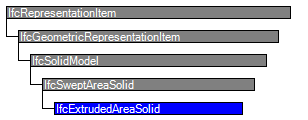Semantic definitions at the entity
Entity definition
The extruded area solid (IfcExtrudedAreaSolid) is defined by sweeping a bounded planar surface. The direction of the extrusion is given by the ExtrudedDirection attribute and the length of the extrusion is given by the Depth attribute. If the planar area has inner boundaries, i.e. holes defined, then those holes shall be swept into holes of the solid.
New: The IfcExtrudedArea solid now directly defines the linear extrusion of a cross section (also referred to as profile). It thereby combines the functionality of the previous IfcAttDrivenExtrudedSegment entity. In contrary to the previous IfcAttDrivenExtrudedSegment, the extruded direction can be any which is not perpendicular to the z axis of the position coordinate system.
The ExtrudedDirection is given within the position coordinate system as defined by IfcSweptAreaSolid.Position. Extrusions are not longer restricted to be perpendicular to the extruded surface of the profile.
NOTE Corresponding STEP entity: extruded_area_solid. Please refer to ISO/IS 10303-42:1994, p. 183 for the final definition of the formal standard. The data type of the inherited SweptArea attribute is different, i.e. of type IfcProfileDef. The Position attribute has been added to position the cross section used for the linear extrusion.
HISTORY New entity in IFC Release 1.5, capabilities of this entity have been enhanced in IFC Release 2x.
Illustration:
Attribute definitions
| # | Attribute | Type | Cardinality | Description | A |
|---|---|---|---|---|---|
| 3 | ExtrudedDirection | IfcDirection | [1:1] | The direction in which the surface is to be swept. | X |
| 4 | Depth | IfcPositiveLengthMeasure | [1:1] | The distance the surface is to be swept. | X |
Formal Propositions
| Rule | Description |
|---|---|
| WR31 | The ExtrudedDirection shall not be perpendicular to the local z-axis. |


 EXPRESS-G diagram
EXPRESS-G diagram Link to this page
Link to this page